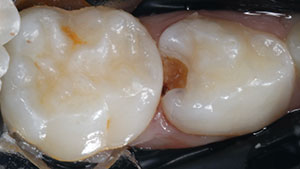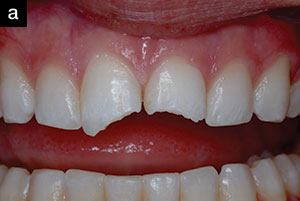Taking impressions on pediatric patients can prove to be clinically difficult. The patient tends to exhibit apprehension, poor cooperation, and rejection due to the unfamiliar task. In addition, the gag reflex and hyperactive tongue may cause the patient to be overcome with fear. The practitioner can become frustrated with the patient and materials, which often leads to avoidance or treatment referral.
Prevention of space loss can be achieved with space maintainers.1 The band and loop space maintainer is associated with the least number of problems.2 Problems with other appliances hinder their use. For example, lingual arches prove to have the lowest survival rate,5 glass fiber-reinforced composite resins (GFRCR) are for short-term use,6 and removable appliances fail due to poor compliance. Band and loop space maintainers allow unhindered eruption of permanent teeth into proper alignment and occlusion.1
This paper presents a new technique for impressions of bands for fixed appliances, specifically space maintainers, thereby hopefully alleviating frustration for both the dentist and patient.
BACKGROUND
Contemporary impression techniques consist of alginate and a combination of alginate and wax (green stick compound) for the fabrication of fixed appliances. Although alginate has widespread use due to its commonality and low cost, alginate impressions have several shortcomings,7 which include the following:
• difficulty establishing a proper liquid-to-powder ratio to create a consistency that flows minimally
• difficulty establishing proper water temperature to create proper consistency
• flow of material posteriorly down the patient’s airway, which can cause apprehension and/or rejection of the procedure
• suction of set material, which causes impression withdrawal to be difficult
• low tear strength
• easy distortion of the material
• less accuracy than polyvinyl siloxane impressions
• necessity to pour up impression immediately to minimize distortion
• poor ability to withdraw bands from tooth.
METHODS AND MATERIALS
TempTray (Clinician’s Choice) is a disposable aluminum quadrant tray for temporary prosthodontic impressions prior to tooth preparation. The TempTray is utilized to fabricate custom temporary restorations. Template (Clinician’s Choice) is a silicone-based material that has a working time of 30 seconds and a set time of 30 seconds. It is very thixotropic, does not slump, and has excellent dimensional stability. Clinician’s Choice has not indicated pediatric applications for TempTray or Template. The author has developed the pediatric application through clinical trials.
The technique is a modified impression technique using solely Template. For simple, unilateral, fixed space maintainers, the author suggests using a TempTray with Template. The technique will be presented in detail.
UNILATERAL SPACE MAINTAINERS
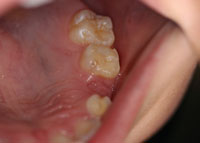 |
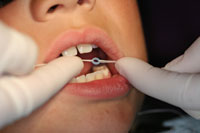 |
|
Figure 1. Pretreatment diagnostic photo. |
Figure 2. Placement of separator. |
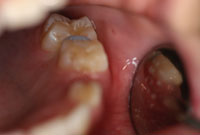 |
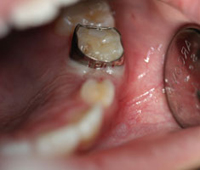 |
|
Figure 3. Position of separator intraorally. |
Figure 4. Position of band intraorally. |
Confirm the necessity of a space maintainer by proper diagnosis. In this case, tooth No. 64 was extracted due to nonrestorability (Figure 1), and a unilateral band and loop space maintainer was treatment planned to prevent the unwanted mesial drift of teeth Nos. 65 and 26.8 A separator (Figure 2) had been placed between teeth Nos. 65 and 26 following the extraction and maintained for a few days prior to the impression (Figure 3). Before the impression was taken, the separator was removed, and a stainless steel band was fitted on tooth No. 65 (Figure 4).
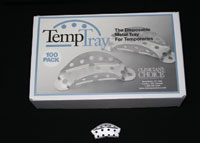 |
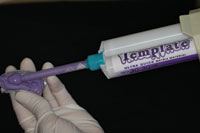 |
|
Figure 5. TempTray disposable tray. |
Figure 6. Placement of Template into TempTray. |
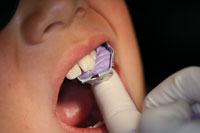 |
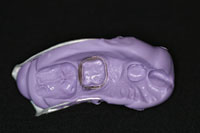 |
|
Figure 7. Thirty-second intraoral impression of band and loop. |
Figure 8. Impression of dentition and band. |
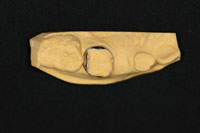 |
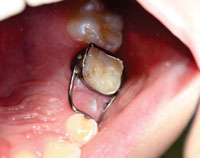 |
|
Figure 9. Model of the impression. |
Figure 10. Band and loop appliance cemented intraorally. |
TempTray (Figure 5) loaded with Template (Figure 6) was utilized for the impression. The material was allowed to set for about 30 seconds and then was placed in the mouth and allowed to set for 30 seconds (Figure 7). The TempTray with Template was removed, retaining the band that had been placed on tooth No. 65 (Figure 8). The impression was disinfected and poured with standard dental stone (Figure 9). To reduce cost and time, the model was poured in our in-house lab, but the practitioner has the ability to send the impression directly to the lab.
The model was sent to a commercial lab for the fabrication of a band and loop space maintainer from teeth Nos. 65 to 63. The fixed unilateral space maintainer was cemented with Poly-F Plus cement (DENTSPLY), completing the treatment. Figure 10 shows the band and loop appliance intraorally prior to its removal upon eruption of the permanent molars.
Discussion
The Template impression technique offers the practitioner a simple and efficient method to perform pediatric impressions. The technique offers the child-patient a quick and simple procedure that is easy to tolerate and allows the clinician to perform an accurate, efficient, and inexpensive impression for the fabrication of fixed appliances. The advantages of this approach include its extremely simple method, its fast and efficient technique, its extreme accuracy and easy retention of the band on withdrawal, no need for specialized equipment, the dimensional stability of Template, excellent patient acceptance, and inexpensive costs.
Conclusion
This author has developed the Template pediatric impression technique to address the shortcomings of traditional pediatric impression techniques. The new technique represents a fast and efficient method for the accurate impression of band-related, fixed, unilateral space maintainers. The technique can be well-tolerated by the apprehensive child-patient and facilitates the procedure for clinicians and staff.
Acknowledgment
The author would like to thank Dr. Len Boksman for his assistance with this article and recognize POW Dental Laboratories for the fabrication of the appliance.
References
1. Bijoor RR, Kohli K. Contemporary space maintenance for the pediatric patient. N Y State Dent J. 2005;71:32-35.
2. Durward CS. Space maintenance in the primary and mixed dentition. Ann R Australas Coll Dent Surg. 2000;
15:203-205.
3. Rocha MJ, Cardoso M, de Oliveira J. Avulsion of posterior primary teeth and space maintaining appliance: case report. J Clin Pediatr Dent. 2000; 25:35-39.
4. Northway WM. The not-so-harmless maxillary primary first molar extraction [published correction appears in J Am Dent Assoc. 2001;132:154]. J Am Dent Assoc. 2000;131:1711-1720.
5. Rajab LD. Clinical performance and survival of space maintainers: evaluation over a period of 5 years. ASDC J Dent Child. 2002;69:156-160.
6. Kargul B, Caglar E, Kabalay U. Glass fiber reinforced composite resin space maintainer: case reports. J Dent Child (Chic). 2003; 70:258-261.
7. Craig RG. Restorative Dental Materials. 9th ed. St Louis, Mo: Mosby-Year Book; 1993:283-383.
8. Cameron AC, Widmer RP. Handbook of Pediatric Dentistry. St Louis, Mo: Mosby-Year Book; 1997:268-271.
Dr. Kalman maintains a private practice in aesthetic and general dentistry in London, Ontario, and is an adjunct professor in the Department of Oral and Maxillofacial Surgery at the School of Dentistry, University of Western Ontario. He can be reached at (519) 672-3401 or by visiting 4seasonsdental.ca.






